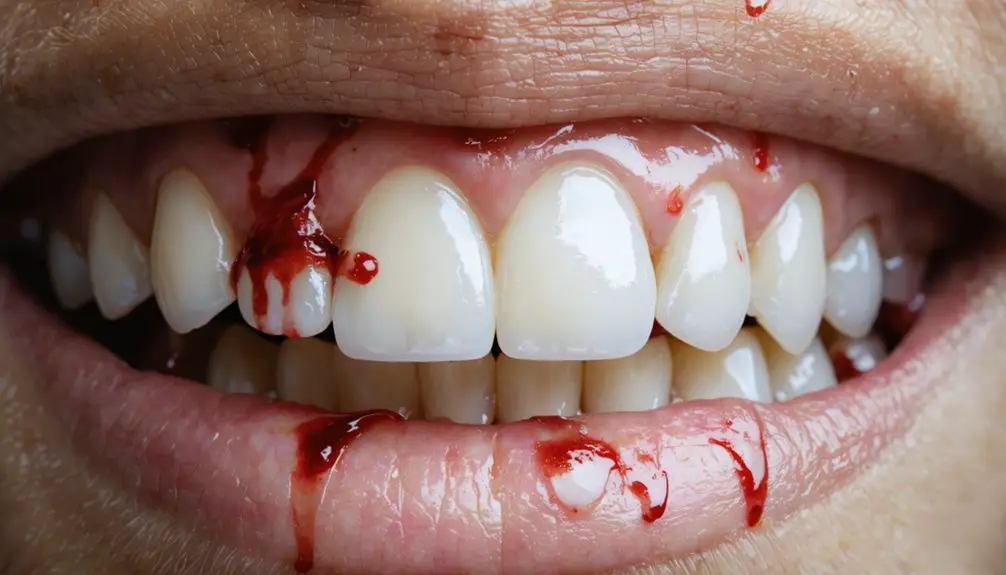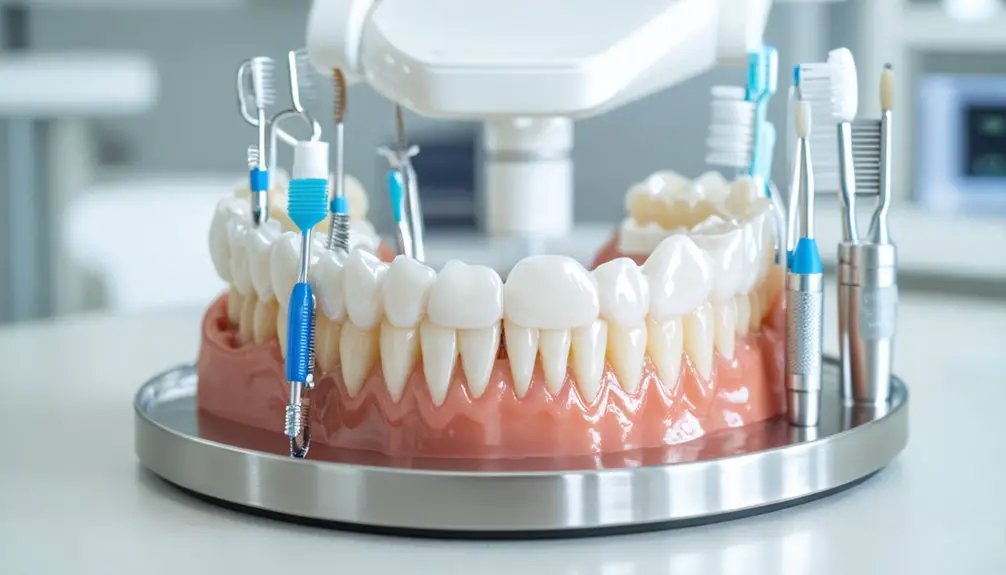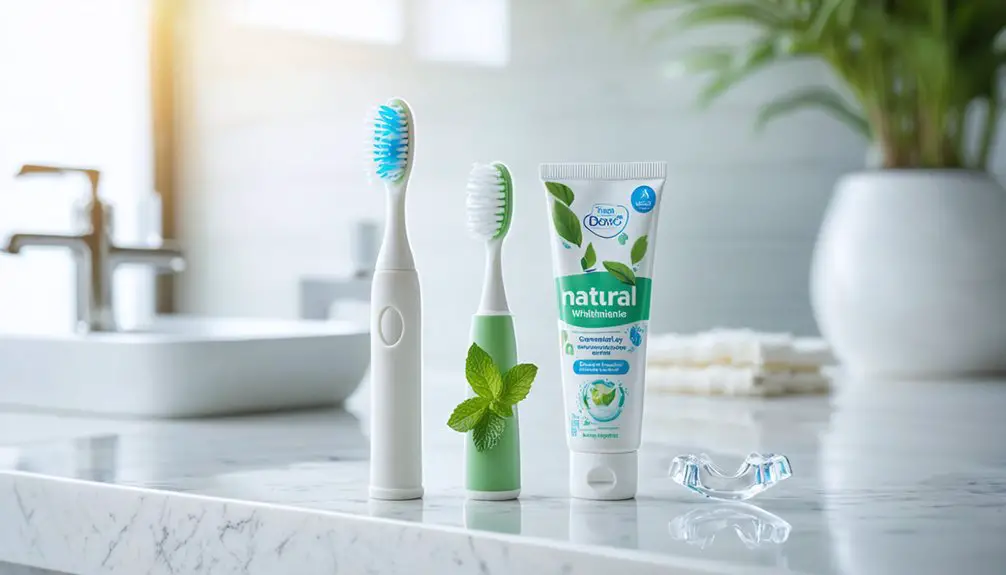When you undergo teeth whitening treatment, you’ll need to evaluate several potential risks. The most common issues include temporary tooth sensitivity to temperature changes and sweet substances, along with possible gum irritation from chemical exposure. You might experience uneven results or, in cases of improper application, damage to your tooth enamel’s protective structure. While most side effects resolve within days, understanding proper treatment protocols can help you minimize these complications.
Key Takeaways
- Tooth sensitivity can occur during treatment due to temporary enamel demineralization, causing discomfort from temperature changes and sweet substances.
- Chemical exposure from whitening agents may cause gum irritation and tissue damage, requiring 24-48 hours for recovery.
- Repeated whitening treatments can weaken tooth enamel structure, increasing vulnerability to future staining and dental problems.
- Improper application or overuse of whitening products may lead to chemical burns on gums and surrounding oral tissues.
- People with existing dental issues, pregnancy, or certain medical conditions should avoid teeth whitening due to increased risks.
Understanding Tooth Sensitivity During Whitening
Why do so many people experience tooth sensitivity during whitening treatments? The answer lies in how whitening agents affect your tooth structure.
When you apply peroxide-based whitening products, they cause temporary demineralization of your tooth enamel, making it more porous. This increased porosity exposes microscopic channels called dentinal tubules that connect the surface to underlying nerve endings.
As these tubules become exposed, they transmit external stimuli more readily to the nerves within your teeth. Temperature changes, pressure, and even sweet or acidic substances can trigger discomfort. Modern whitening products often include anti-sensitivity medications to help minimize this discomfort.
The whitening gel’s ability to penetrate the enamel temporarily increases its permeability, leaving the sensitive dentin layer and nerve endings more vulnerable. Using higher concentration bleach in whitening products significantly increases the likelihood of experiencing sensitivity.
Fortunately, this sensitivity is usually temporary, resolving as your teeth naturally remineralize after treatment.
Gum Irritation and Tissue Damage
To prevent gum sensitivity during teeth whitening, you’ll need to guarantee proper application techniques and use protective barriers that shield your gum tissue from whitening agents. Using petroleum jelly barriers helps create a protective layer between whitening agents and sensitive gum tissue.
If you experience gum irritation, you should immediately discontinue whitening treatments and rinse thoroughly with water to minimize chemical burn damage.
Your gum tissue typically requires 24-48 hours to recover from mild chemical exposure, though more severe cases may need professional evaluation and extended healing time. Professional whitening treatments can significantly reduce the risk of gum irritation through precise application and customized trays.
Preventing Gum Sensitivity Issues
While teeth whitening treatments can effectively brighten your smile, they pose significant risks for gum sensitivity and tissue damage when not properly administered.
To protect your patients’ gum health, guarantee they receive professional-grade whitening techniques with properly fitted trays or in-office treatments using protective barriers. Dental supervision is essential for safe and effective whitening outcomes. Careful application and strict adherence to treatment duration help prevent chemical burns from peroxide-based agents. Using desensitizing gels or fluoride can provide quick relief from irritation and discomfort.
For best gum care, recommend lower peroxide concentrations for sensitive patients and avoid treatments if active gum disease is present.
Screen patients for preexisting conditions like gum recession that could increase sensitivity risks. Monitor for signs of irritation, including redness, swelling, or stinging sensations. If symptoms persist beyond a few days, evaluate for potential tissue damage and adjust treatment protocols accordingly.
Managing Tissue Recovery Time
Understanding tissue recovery time after teeth whitening procedures is essential for proper patient care and treatment planning.
You’ll need to assess the severity of gum irritation, which typically falls into three categories: mild cases healing within 1-3 days, moderate burns requiring 3-7 days, and severe cases taking up to two weeks for complete recovery.
Applying vitamin E gel directly to affected areas can help soothe irritated gum tissue and promote healing.
To implement effective recovery strategies, you should recommend salt water rinses and cold compresses to reduce inflammation, while advising patients to avoid spicy or acidic foods.
Using a custom-fit tray during treatment significantly reduces the risk of chemical burns to gum tissue.
Monitoring progress is vital – watch for persistent redness, white patches, or increased sensitivity. If symptoms don’t improve, direct patients to seek professional consultation.
Remember that proper application techniques and well-fitted trays can greatly reduce the risk of tissue damage during whitening treatments.
Long-Term Effects on Dental Enamel
Although teeth whitening has become increasingly popular for achieving a brighter smile, its long-term effects on dental enamel warrant careful consideration.
Your tooth enamel’s protective function can become compromised through repeated exposure to whitening agents, leading to enamel degradation and increased chemical sensitivity. The use of hydrogen peroxide agents in whitening treatments requires careful monitoring to prevent potential damage to this vital tooth layer. Professional treatments offer customized concentrations based on individual enamel conditions.
When you’re considering teeth whitening, be aware of these critical impacts:
- Aggressive bleaching treatments can demineralize your enamel’s surface, weakening its structural integrity and natural defense against decay.
- Prolonged exposure to whitening agents may cause permanent changes to your enamel’s microstructure, increasing vulnerability to future staining.
- Once enamel damage occurs, it’s irreversible, as your teeth can’t naturally regenerate this protective layer.
Regular dental monitoring and professional guidance remain essential to preserve your enamel’s health during whitening procedures.
Achieving Even Results: Challenges and Concerns
The pursuit of uniformly whitened teeth presents significant technical challenges that extend beyond basic enamel protection concerns.
Your teeth’s natural enamel variability affects how whitening agents penetrate and interact with different areas of each tooth. You’ll find that thinner enamel regions, typically near tooth edges, whiten faster than thicker sections, creating noticeable color disparities.
If you’ve got dental restorations like crowns or veneers, they won’t respond to whitening treatments, leading to potential mismatches with your natural teeth.
Deep-set stains from coffee, tea, or smoking can resist surface whitening unevenly. Additionally, poorly fitting trays or uneven application of whitening products can result in patchy outcomes.
These challenges are compounded by demineralization effects, which may cause temporary white spots or streaks across your teeth’s surface.
Protecting Your Dental Health During Treatment
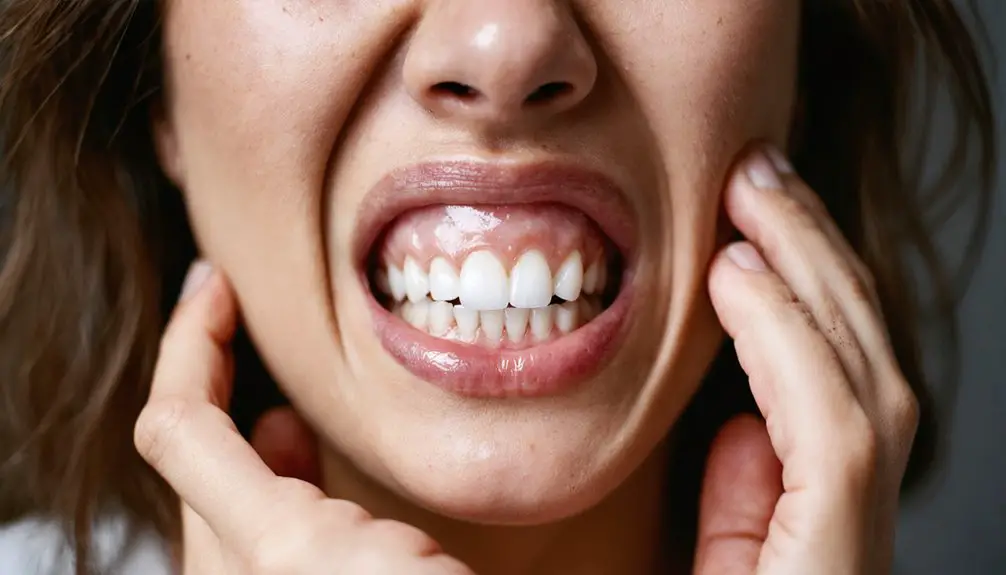
When pursuing teeth whitening treatments, protecting your dental health requires a thorough approach that addresses multiple risk factors simultaneously.
Before considering whitening alternatives, consult a dental professional to assess your oral health and identify potential complications. Professional recommendations typically focus on preserving enamel integrity while achieving desired results.
Follow these essential protective measures during treatment:
- Use custom-fitted trays and professional-grade products to minimize gum exposure and guarantee even application.
- Apply desensitizing agents before and after treatment to reduce tooth sensitivity and support enamel remineralization.
- Monitor treatment duration and frequency, allowing adequate recovery time between sessions.
If you experience severe sensitivity or gum irritation, discontinue treatment immediately and seek professional guidance.
Regular dental check-ups throughout the whitening process help maintain ideal safety and effectiveness.
Managing Post-Treatment Discomfort
Successfully managing post-treatment discomfort requires understanding the typical symptoms and implementing targeted relief strategies.
When you experience sensitivity or “zingers” after whitening, use desensitizing toothpaste containing potassium nitrate or fluoride to calm nerve endings and strengthen your enamel. Rinse with warm saltwater to reduce gum inflammation and soothe irritated tissues.
To minimize discomfort, avoid hot, cold, and acidic foods during recovery. If recommended by your healthcare provider, take over-the-counter pain relievers for moderate pain management.
For persistent sensitivity, consider professional fluoride treatments. Should you experience severe pain lasting more than a few days or intense gum irritation with swelling, seek immediate dental evaluation to rule out complications and protect your oral health.
Duration and Maintenance of Whitening Results
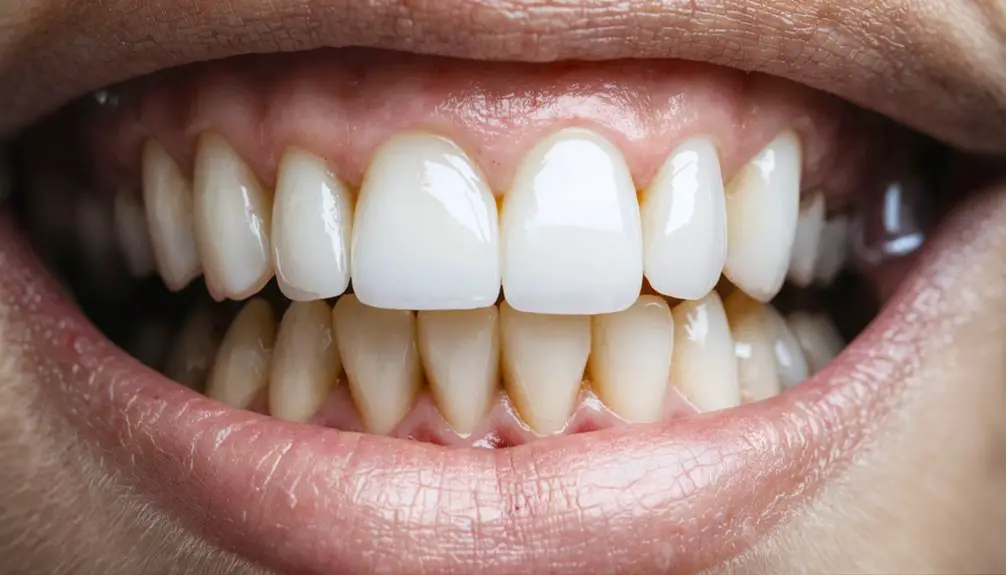
Your teeth whitening results can last between 6 months to 2 years, though this duration varies greatly based on your lifestyle choices and oral hygiene practices.
To maintain your brightened smile, you’ll need to minimize exposure to staining agents like coffee, tea, and tobacco while following proper dental care routines.
Professional touch-up treatments are typically recommended every 6 to 12 months, with at-home maintenance options available to extend the longevity of your results.
Lifespan of Whitening Effects
Although teeth whitening treatments can deliver dramatic results, the duration of these effects varies greatly among individuals and typically spans from several months to three years.
The whitening duration depends on multiple factors, particularly your lifestyle choices and oral care routine. To understand what influences the lifespan of your whitening treatment, consider these key factors:
- Professional treatments combined with monthly home maintenance show better color stability at 6 months compared to standalone procedures.
- Re-staining factors like coffee, red wine, and tobacco can greatly reduce the longevity of your results.
- Your natural tooth color and type of discoloration affect how long the whitening effects will last.
You’ll achieve ideal longevity through consistent oral hygiene and minimizing exposure to staining agents, regardless of the whitening agent’s concentration.
Maintaining Your Bright Smile
Maintaining a bright smile after teeth whitening requires an all-encompassing approach that combines proper oral hygiene, dietary modifications, and strategic maintenance treatments.
Your dietary choices greatly impact whitening longevity – coffee, tea, and red wine can accelerate re-staining, while drinking through straws helps minimize contact with teeth. Positive lifestyle habits, including twice-daily brushing with whitening toothpaste and daily flossing, are essential for preserving your results.
For ideal maintenance, you’ll need to schedule professional cleanings every six months and consider using dentist-recommended touch-up treatments every 4-6 weeks.
You can extend your whitening results up to a year or more by avoiding tobacco, limiting chromogenic substances, and maintaining proper hydration. Your dentist can create a personalized maintenance plan based on your specific oral conditions and habits.
Touch-up Treatment Schedule
Successful teeth whitening results require strategic touch-up treatments to maintain their brilliance over time. Your touch-up frequency will depend on various lifestyle factors, including dietary habits and oral hygiene practices.
While most patients require touch-ups every 6-12 months, those who consume staining substances may need more frequent maintenance.
To maximize whitening longevity, follow these essential guidelines:
- Schedule touch-ups during regular dental check-ups to guarantee ideal enamel condition.
- Limit touch-up sessions to 15-30 minutes daily during treatment periods.
- Avoid staining substances for at least 48 hours post-treatment.
Professional monitoring helps determine your ideal maintenance schedule based on individual needs.
Consider scheduling touch-ups before receiving new dental work to guarantee proper color matching between natural teeth and restorations.
When to Avoid Teeth Whitening Procedures

While teeth whitening procedures can enhance your smile’s appearance, numerous medical conditions and circumstances warrant avoiding these treatments altogether.
Major whitening contraindications include pregnancy, lactation, and systemic conditions like cancer, diabetes, and heart disease. You’ll need to seek safe alternatives if you’re under 16 years old, as developing teeth are particularly vulnerable to damage from bleaching agents.
Don’t pursue whitening if you have active dental issues like decay, gum disease, or exposed roots. The presence of large fillings, crowns, or dental work can result in uneven coloring.
You should also avoid these treatments if you have sensitive teeth, allergies to peroxide, or are taking medications that may interact with whitening agents, such as tretinoin or doxycycline.
Frequently Asked Questions
Can Teeth Whitening Affect Existing Dental Bonding or Sealants?
Your whitening treatment won’t change the color of dental bonding or sealants, leading to potential bonding discoloration mismatches with natural teeth. Additionally, harsh whitening agents could compromise sealant integrity over time.
Is It Safe to Whiten Teeth While Wearing Clear Dental Aligners?
You shouldn’t whiten teeth while wearing aligners, as most whitening agents can damage aligner material. If you’re considering treatment, discuss aligner compatibility and whitening duration with your orthodontist for safer alternatives.
How Does Smoking Impact the Effectiveness of Teeth Whitening Treatments?
While you can whiten teeth as a smoker, smoking’s chemicals greatly reduce whitening longevity by creating barriers on enamel, interfering with bleaching agents, and causing rapid re-staining that diminishes your treatment’s effectiveness.
Can Certain Medications Interfere With Teeth Whitening Results?
Yes, medications can greatly affect your whitening results through intrinsic staining, medication interactions, and increased whitening sensitivity, especially antibiotics like tetracycline that cause deep internal tooth discoloration.
Does Teeth Whitening Affect the Strength of Previous Root Canal Work?
You’ll be relieved to know that professional whitening won’t compromise your root canal work. Like Dr. Smith’s recent patient, following proper whitening safety precautions prevents root canal sensitivity while maintaining your tooth’s structural integrity.
References
- https://narrewarrendentalcare.com.au/risks-of-teeth-whitening-what-you-need-to-know-before-getting-started/
- https://www.dentistryofwestbend.com/teeth-whitening-risks-and-side-effects/
- https://pmc.ncbi.nlm.nih.gov/articles/PMC4058574/
- https://harborcreekdental.com/side-effects-of-teeth-whitening/
- https://www.healthline.com/health/is-teeth-whitening-safe
- https://harrisburgsmilesdental.com/why-does-teeth-whitening-cause-sensitivity-understanding-the-basics/
- https://tooth-doctor.com/severe-tooth-sensitivity-after-teeth-whitening/
- https://familydentistchandler.com/how-to-avoid-teeth-sensitivity-after-whitening/
- https://www.scottgreenhalghdds.com/blog/10-tips-for-dealing-with-sensitivity-after-teeth-whitening
- https://www.wauwatosadentists.com/does-teeth-whitening-cause-tooth-sensitivity/
